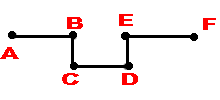
How To Write a Good
Proof
How
to Play | Game
Levels | Reasons | Cards
| Game Board | Writing
Proofs
Have you ever asked, "WHY DO WE HAVE TO LEARN THIS PROOF STUFF ANYWAY? I'M NEVER GOING TO HAVE TO PROVE THAT A RHOMBUS IS A CONVEX QUADRILATERAL IN REAL LIFE!"
Well we sure have.
![]()
Geometry proofs can sometimes
be overwhelming. We at themathlab.com realize
this and have developed  to
try to show you that proof is, like many things, an intellectual GAME.
to
try to show you that proof is, like many things, an intellectual GAME.
It's fun once you get good at it, and being good at it makes your powers of reason MUCH stronger. No, you will probably never need to prove that a rhombus is a convex quadrilateral in "real life", but learning how to do it will develop a strong logical circuit in your brain.
So come on and join us, play
your way to a strong, logical brain. See if you can master all the levels
of  .
.
![]()
The two most important things a proof must possess are clarity and backup.
Over the years, we've read some awful proofs and some wonderful proofs. Without a doubt the wonderful ones were wonderful because WE COULD UNDERSTAND THEM!!!!!
There is absolutely no reason to write a proof unless your reader can understand what you're saying. Keep this in mind as you write. We always try to pretend we are speaking to someone who has very limited mathematical knowledge and who doesn't know what facts we have been "given".
Therefore, when we state a property or a theorem or a definition as backup, we always explain it in the proof. We never assume for example, that our reader knows what the second part of the distance postulate is by memory. We also make sure that we state the necessary parts that have been "given" to us. ASSUME YOUR READER KNOWS VERY LITTLE.
Also keep in mind that THERE IS NEVER JUST ONE WAY OF STATING A PROOF.
Actually there are even several ways of presenting a proof argument:
- There
is the high school textbook, classic, method of writing two columns,
the first being a list of numbered arguments and the second column a
matching list of legal justifications i.e. theorems, definitions, postulates.
Click HERE for an example.
- Then
there is the more "collegiate" method of writing a lengthy
paragraph. This is known as the paragraph method and each sentence is
backed up in prose form with its justification.
Click HERE for an example.
- We at
themathlab.com use a mixture of the two.
We write numbered, complete, sentences which each have a legal math
reason imbedded in them. Our most important goals are KEEP IT EASY TO
UNDERSTAND and KEEP IT LEGAL.
Click HERE for an example.
So don't worry about trying to match a "perfect wording". Just be sure that your statements are clear, and that they are each backed up with a legal reason.
A good measure of the quality of your proof is found by reading it to a person who has not taken a geometry course or who hasn't been in one for a long time. If they can understand your proof by just reading it, and they don't need any verbal explanation from you, then you have a good proof.
Now go play and have some fun growing smarter!
Sincerely,
The staff at themathlab.com
***And for a real relaxing laugh you could read the 36 Humorous Methods of Mathematical Proof, we love them here.***
How to Play | Game Levels | Reasons | Cards | Game Board | Writing Proofs
Home | About
Us | Algebra| Dictionary | Games | Geometry | Gym | Humor | Lab | Magic | Natural Math | PreAlgebra | Resources | Teachers Only | Toolbox | Treasures | Videos | Wonders | Writings |
Copyright © 1999-2020 themathlab.com

